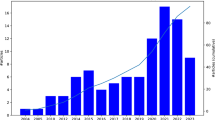Abstract
We study a discrete facility location problem on a network, where the locating firm acts as the leader and other competitors as the followers in a Stackelberg-Cournot-Nash game. To maximize expected profits the locating firm must solve a mixed-integer problem with equilibrium constraints. Finding an optimal solution is hard for large problems, and full-enumeration approaches have been proposed in the literature for similar problem instances. We present a heuristic solution procedure based on simulated annealing. Computational results are reported.



Similar content being viewed by others
Notes
This discussion assumes \(p=1\) (or that the number of “movable” sites is 1) but the same concept applies if \(p>1\) if we assume that two candidate solutions are adjacent if they have \(p-1\) facilities in common and that the remaining facility is adjacent in the sense that it would be for \(p=1\).
References
Arostegui M, Kadipasaoglu S, Khumawala B (2006) An empirical comparison of tabu search, simulated annealing and genetic algorithms for facilities location problems. Int J Prod Econ 103(2):742–754
Berglund P, Kwon C (2013) Robust facility location problem for hazardous waste transportation. Netw Spat Econ (forthcoming)
Cournot A (1838) Recherches sur les principes mathématiques de la théorie des richesses. [Research into the Mathematical Principles of the Theory of Wealth. English translation by N. Bacon. MacMillan, New York, 1897.]
Dafermos S, Nagurney A (1984) Sensitivity analysis for the general spatial economic equilibrium problem. Oper Res 32(5):1069–1086
Dobson G, Kamarkar U (1985) Competitive location on a network. Oper Res 35(4):565–574
Drezner T, Drezner Z, Salhi S (2002) Solving the multiple competitive facilities location problem. Eur J Oper Res 142(1):138–151
Edmunds T, Bard J (1992) An algorithm for the mixed-integer nonlinear bilevel programming problem. Ann Oper Res 34(1):149–162
Eiselt H, Laporte G, Thisse J (1993) Competitive location models: a framework and bibliography. Transp Sci 27(1):44–54
Facchinei F, Pang J-S (2003) Finite-Dimensional variational inequalities and complementarity problems. Springer-Verlag
Friesz T (2010) Dynamic optimization and differential games. Springer
Friesz T, Harker P, Tobin R (1984) Alternative algorithms for the general network spatial price equilibrium problem. J Reg Sci 24(4):475–507
Friesz T, Miller T, Tobin R (1988) Competitive network facility location models: a survey. Pap Reg Sci Assoc 65(1):47–57
Friesz T, Tobin R, Miller T (1989) Existence theory for spatially competitive network facility location models. Ann Oper Res 18(1):267–276
Friesz T, Rigdon M, Mookherjee R (2006) Differential variational inequalities and shipper dynamic oligopolistic network competition. Transp Res B 40(6):480–503
Gabriel S, Shim Y, Conejo A, de la Torre S, Garcia-Bertrand S (2010) A Benders decomposition method for discretely-constrained mathematical programs with equilibrium constraints. J Oper Res Soc 61(9):1404–1419
Golden B, Skiscim C (1986) Using simulated annealing to solve routing and location problems. Nav Res Logist Q 33(2):261–279
Hale TS, Moberg CR (2003) Location science research: a review. Ann Oper Res 123(1–4):21–35
Harker P (1984) A variational inequality approach for the determination of oligopolistic market equilibrium. Math Program 30(1):105–111
Harker P (1986) Alternative models of spatial competition. Oper Res 34(3):410–425
Harker PT, Pang J-S (1990) Finite-dimensional variational inequality and nonlinear complementarity problems: a survey of theory, algorithms and applications. Math Program 48(1–3):161–220
Konur D, Geunes J (2012) Competitive multi-facility location games with non-identical firms and convex traffic congestion costs. Transp Res E Logist Transp Rev 48(1):373–385
Kress D, Pesch E (2011), Sequential competitive location on networks. Eur J Oper Res (in press). doi:10.1016/j.ejor.2011.06.036
Luo Z, Pang J, Ralph D (1996) Mathematical programs with equilibrium constraints. Cambridge University Press, Cambridge
Miller T, Tobin R, Friesz T (1991) Stackelberg games on a network with cournot-nash oligopolistic competitors. J Reg Sci 31(4):435–454
Miller T, Friesz T, Tobin R (1992) Heuristic algorithms for delivered price spatially competitive network facility location problems. Ann Oper Res 34(1):177–202
Miller TC, Friesz TL, Tobin RL (1996) Equilibrium facility location on networks. Springer-Verlag, Berlin, Heidelberg, New York
Miller T, Friesz T, Tobin R, Kwon C (2007) Reaction function based dynamic location modeling in Stackelberg-Nash-Cournot competition. Netw Spat Econ 7(1):77–97
Murray A, Church R (1996) Applying simulated annealing to location planning models. J Heuristics 2(1):31–53
Nagurney A (1987) Computational comparisons of spatial price equilibrium methods. J Reg Sci 27(1):55–76
Nagurney A (1999) Network economics: a variational inequality approach, 2nd edn. Kluwer Academic Publishers, Dordrecht
Parvaresh F, Golpayegany SH, Husseini SM, Karimi B (2013) Solving the p-hub median problem under intentional disruptions using simulated annealing. Netw Spat Econ. (forthcoming)
Plastria F (2001) Static competitive facility location: an overview of optimisation approaches. Eur J Oper Res 129(3):461–470
Plastria F, Vanhaverbeke L (2007) Aggregation without loss of optimality in competitive location models. Netw Spat Econ 7(1):3–18
Redondo JL, Fernández J, Garcáa I, Ortigosa PM (2009) Solving the multiple competitive facilities location and design problem on the plane. Evol Comput 17(1):21–53
Samuelson P (1952) Spatial price equilibrium and linear programming. Am Econ Rev 42(3):283–303
Santos-Peñate DR, Suárez-Vega R, Dorta-González P (2007) The leader-follower location model. Netw Spat Econ 7(1):45–61
Serra D, ReVelle C (1999) Competitive location and pricing on networks. Geogr Anal 31(2):109–129
Shahabi M, Akbarinasaji S, Unnikrishnan A, James R (2013) Integrated inventory control and facility location decisions in a multi-echelon supply chain network with hubs. Netw Spat Econ (forthcoming). http://link.springer.com/article/10.1007%2Fs11067-013-9196-4
Sherali H, Soyster AL, Murphy FH (1983) Stackelberg-Nash-Cournot equilibria: characterizations and computations. Oper Res 31(2):253–276
Takayama T, Judge GG (1971) Spatial and temporal price and allocation models. North-Holland, Amsterdam
Tobin R, Friesz T (1986) Spatial competition facility location models: definition, formulation and solution approach. Ann Oper Res 6(3):47–74
Tobin R, Miller T, Friesz T (1995) Incorporating competitors reactions in facility location decisions: a market equilibrium approach. Locat Sci 3(4):239–253
Author information
Authors and Affiliations
Corresponding author
Rights and permissions
About this article
Cite this article
Berglund, P.G., Kwon, C. Solving a Location Problem of a Stackelberg Firm Competing with Cournot-Nash Firms. Netw Spat Econ 14, 117–132 (2014). https://doi.org/10.1007/s11067-013-9217-3
Published:
Issue Date:
DOI: https://doi.org/10.1007/s11067-013-9217-3




